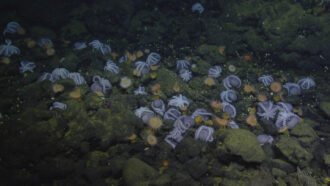RNA Editing: An Expertise of Octopuses and Squid, Preserving DNA Unchanged.

Editors changing a single word in a story may frustrate writers, but the consequences are usually not grave. However, genetic instructions for making proteins are different as even a small change can hinder the protein from functioning properly, leading to disastrous results. Although rare, changes to genetic instructions can be beneficial, but it is generally wise to conserve the genetics as they are, except if you happen to be an octopus.
Octopuses are like alien creatures that live among us. These creatures perform a variety of tasks differently from land and sea animals. Their flexible tentacles have minds of their own and they taste whatever they touch. Octopuses' eyes are color-blind, but their skin detects light in a unique manner. They are experts in the art of camouflage, blending into their surroundings to hide from predators or to scare away competitors. Additionally, they excessively modify the molecular equivalent of red ink over their genetic instructions, akin to a copy editor gone completely rogue.
These modifications alter RNA, the molecule used for interpreting information from the genetic blueprint stored in DNA, while leaving the DNA unchanged.
The reasons that cephalopods, such as octopuses, cuttlefish, and squid, are such prolific editors are still unknown among researchers. Scientists are analyzing if this form of genetic editing gave cephalopods and evolutionary advantage or if editing is only a useful accident. They are also exploring the consequences of RNA alterations under different conditions. Some evidence suggests that editing may enhance the cephalopods' intelligence while being detrimental to DNA evolution.
Caroline Albertin, a comparative developmental biologist at the Marine Biological Laboratory in Woods Hole, Mass., describes octopuses as "magical" animals with various solutions to problems they encounter in their world. RNA editing may give these creatures multiple solutions for these problems.
According to molecular biology's central dogma, the instructions for building an organism are contained in DNA. The cells copy these instructions into messenger RNA, or mRNA. Cellular machinery called ribosomes then reads mRNA to create proteins by connecting amino acids. Most of the time, the protein's makeup is similar to the DNA template for the protein sequence of amino acids.
RNA editing can cause variations from the DNA instructions, resulting in some proteins with different amino acids than those specified by the DNA.
Editing chemically modifies one of RNA's four building blocks, which are often referred to by the first letters of their names: A, C, G, and U, for adenine, cytosine, guanine, and uracil (RNA's version of the DNA base thymine). In an RNA molecule, the bases are connected to sugars. For instance, the adenine-sugar unit is called adenosine.
Cephalopods are highly adept at a type of editing referred to as adenosine to inosine, or A-to-I editing. This process occurs when ADAR2, an enzyme, removes a nitrogen atom and two hydrogen atoms from adenosine, turning it into inosine.
Ribosomes read inosine as guanine instead of adenine. This switch has no effect on the resulting protein amino acid chain in some cases. In others, the replacement of A with G results in a diverse amino acid being added to the protein. Such RNA editing, which changes the protein, is called RNA recoding.
Soft-bodied cephalopods have wholeheartedly embraced RNA recoding while closely related species have exhibited more caution. Albertin notes that "Other mollusks don't seem to do it" to the same degree.
RNA editing is not only limited to underwater creatures. Almost all multicellular organisms contain RNA editing enzymes called ADAR enzymes, short for "adenosine deaminase that acts on RNA," according to Joshua Rosenthal, a molecular neurobiologist from the Marine Biological Laboratory.
Cephalopods have two ADAR enzymes, which humans also have. "In our brains, we edit a ton of RNA. We do it a lot," Rosenthal explains. Scientists have discovered millions of sites in human RNAs where RNA editing occurs.
\n\nAccording to Kavita Rangan, a molecular biologist at the University of California, San Diego, the complexity seen in cephalopod RNA recoding would only be possible if every site were independent. Rangan's research focuses on RNA recoding in the California market squid (Doryteuthis opalescens) and the longfin squid. The water temperature triggers the cephalopod to recode motor proteins called kinesins that move cargo inside cells.
Rangan examined mRNAs in the optic lobe and stellate ganglion of the longfin squid and found that the mRNA responsible for producing kinesin-1 has 14 recoding sites. Each tissue made several versions of the protein, but certain sites were edited together. This suggests that editing is coordinated and challenges the idea that editing is independent. However, RNA editing provides cephalopods a way to try out many versions of a protein without getting locked into a permanent change in DNA, Rangan explains.
While RNA editing may prevent cephalopods from reaching their pinnacle of complexity, RNA editing may provide an evolutionary advantage. Jianzhi Zhang, an evolutionary geneticist at the University of Michigan in Ann Arbor, found that recoding in humans happens less frequently than in cephalopods. Most cases of recoding in cephalopods are not advantageous. Zhang and then-graduate student Daohan Jiang proposed a harm-permitting model that suggests RNA editing may stick around not because it is adaptive but because it is addictive. RNA editing may correct mistakes in DNA that lead to harmful amino acid changes in proteins. In this case, RNA editing becomes indispensable to the organism's survival.
While Zhang argues that editing is neutral, other research suggests RNA editing can be adaptive.
\nRNA editing may work as a transition phase, letting organisms try out a switch from adenine to guanine without making a permanent change in their DNA. Over the course of evolution, sites where adenines are recoded in RNA in one cephalopod species are more likely than unedited adenines to be replaced with guanine in the DNA of one or more related species, researchers reported in 2020 in PeerJ. And for heavily edited sites, evolution across cephalopods seems to favor a transition from A to G in DNA (rather than to cytosine or thymine, the other two DNA building blocks). That favors the idea that editing can be adaptive.
Other recent work by Rosenthal and colleagues, which examined A-to-G replacements in different species, suggests that having an editable A is an evolutionary boon over an uneditable A or a hardwired G.
Soft-bodied cephalopod species including octopuses, squid and cuttlefish recode RNA in their nervous systems at tens of thousands of sites, compared with about a thousand or fewer sites in humans, mice, fruit flies and other animal species. Though scientists have been documenting the number of editing sites, they will need new tools to directly test how recoding influences cephalopod biology.
Evidence for and against RNA recoding’s evolutionary value has come mainly from examining the total genetic makeup, or genomes, of various cephalopod species. But scientists would like to directly test whether recoded RNAs have an effect on cephalopod biology. Doing that will require some new tools and creative thinking.
Rangan tested synthetic versions of squid motor proteins and found that two edited versions that squid make in the cold moved slower but traveled farther along protein tracks called microtubules than unedited proteins did. But that’s in artificial laboratory conditions on microscope slides. To understand what is happening in cells, Rangan says, she would like to be able to grow squid cells in lab dishes. Right now, she has to take tissue directly from the squid and can only get snapshots of what is happening. Lab-grown cells might allow her to follow what happens over time.
Zhang says he is testing his harm-permitting hypothesis by getting yeast hooked on RNA editing. Baker’s yeast (Saccharomyces cerevisiae) doesn’t have ADAR enzymes. But Zhang engineered a strain of the yeast to carry a human version of the enzyme. The ADAR enzymes make the yeast sick and grow slowly, he says. To speed up the experiment, the strain he is using has a higher-than-normal mutation rate, and may build up G-to-A mutations. But if RNA editing can correct those mutations, the ADAR-carrying yeast may grow better than ones that don’t have the enzyme. And after many generations, the yeast may become addicted to editing, Zhang predicts.
Albertin, Rosenthal and colleagues have developed ways to change the genes of squid with the gene editor CRISPR/Cas9. The team created an albino squid by using CRISPR/Cas9 to knock out, or disable, a gene that produces pigment. The researchers may be able to change editing sites in DNA or in RNA and test their function, Albertin says.
This science is still in its early stages, and the story may lead somewhere unexpected. Still, with cephalopods’ skillful editing, it’s bound to be a good read.
Our mission is to provide accurate, engaging news of science to the public. That mission has never been more important than it is today.
As a nonprofit news organization, we cannot do it without you.
Your support enables us to keep our content free and accessible to the next generation of scientists and engineers. Invest in quality science journalism by donating today.




